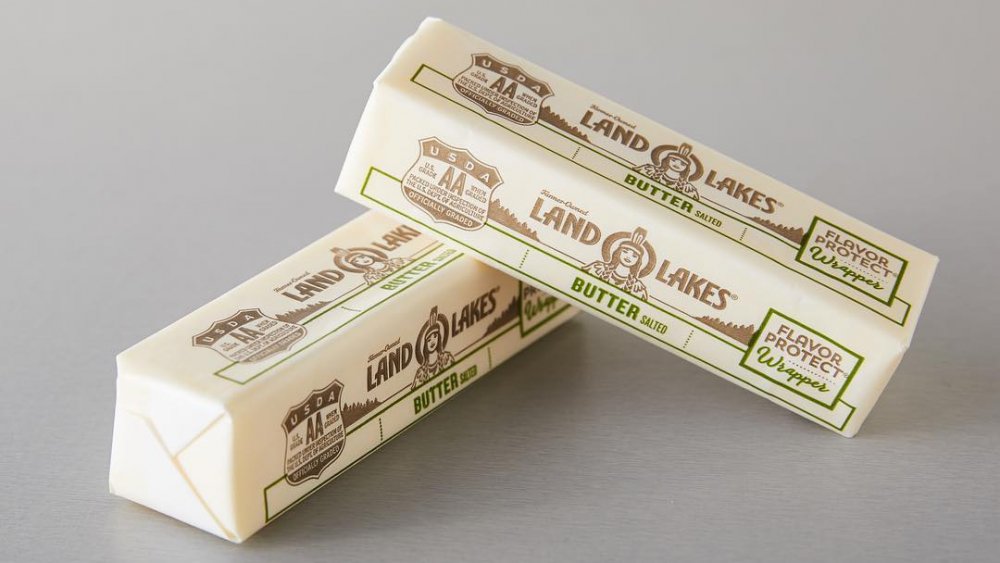The Real Reason Land O'Lakes Changed Their Packaging
If you're a brand-name butter buyer, you might start to notice something a little bit different on the supermarket shelves over the next few months. Land O'Lakes, America's best-selling butter (via Food & Wine), sent out a press release in February announcing a major redesign of its packaging to celebrate its upcoming centennial. According to Land O'Lakes President and CEO Beth Ford, "As Land O'Lakes looks toward our 100th anniversary, we've recognized we need packaging that reflects the foundation and heart of our company culture."
Okay, that's all very well and good, and the new packaging is certainly very tasteful, retaining the green trees and sky-blue waters reminiscent of the butter brand's native Minnesota. But wait, isn't there something missing? Or rather, someone? Why, yes, the famous Butter Maiden, a lovely Native American lass who, the Twin Cities Pioneer Press informs us, goes by the name of Mia. Or rather, went by that name, as she appears to be no more. While Land O'Lakes did not publicly kill her off a la Mr. Peanut, they quietly pushed her offstage and off the box (we hope not into that lake in front of which she knelt for so many years). So why, apart from the anniversary celebration, did Land O'Lakes take such a major rebranding step? While the corporate spokespeople give one reason, the media seems to favor another possible explanation.
The history of the Butter Maiden
Before we get into the reasons behind her disappearance, here's a little backstory on how Mia came to be, courtesy of the Twin Cities Pioneer Press. She dates back to 1928, when illustrator Arthur C. Hanson came up with an image meant to evoke rural Minnesota on every carton of butter: a blue lake, green pine trees, and of course the obligatory pretty girl, since "sex sells" is a pretty universal advertising truth in any century. He chose to depict a Native American woman in a buckskin dress who was kneeling and holding up a box of the advertised product.
The design was tweaked in 1939 and again in the 1950s, when at which time Minnesota Ojibwe artist Patrick DesJarlait had a hand in its makeover. In more recent years, Land O'Lakes chose to use only part of the image, showing Mia from the shoulders up which had the effect of de-emphasizing the fact that she was kneeling in what could be seen as a subservient posture.
The reason Land O'Lakes is giving for the packaging change
The official explanation given by Ford was that the company wanted to give a shout-out to the dairy farmers who produce their products. The New York Times reveals that Land O'Lakes was founded in 1921 by a group of Minnesota dairy farmers, and is still, nearly 100 years later, a farmer-owned cooperative. As Ford explained in the press release, "As a farmer-owned co-op, we strongly feel the need to better connect the men and women who grow our food with those who consume it."
In recent years, Land O'Lakes has released several advertisements and a music video starring some of the real dairy farmers in the cooperative, and future plans include adorning butter boxes with photos of real Land O'Lakes farmers, much in the way that Wheaties boxes feature those of well-known athletes. Other packaging may feature just the illustration of the lake and trees, but the words "Farmer-Owned" will be prominently featured on each label.
There may be another reason why Land O'Lakes felt it was time for a change
Nobody has beef with Land O'Lakes buttering up dairy farmers, particularly when their industry's in freefall and milk prices are reaching new lows. Some are speculating, though, that Land O'Lakes' real reason for the packaging change may have been a wish to disassociate itself from a symbol now seen as embarrassing, outdated, and downright racist. What's more, North Dakota state Rep. Ruth Buffalo, D-Fargo, a member of the Mandan, Hidatsa and Arikara Nation, points out that the Butter Maiden is depicted as a sex object, so the symbol is misogynistic as well as racist.
The change in packaging has been well-received by members of the Native American community. Kevin Allis, chief executive of the National Congress of American Indians, told The New York Times that "discarding antiquated symbols like this [is] a step in the right direction," and that his organization "encourage[s] all companies that peddle products displaying stereotypical Native 'themed' imagery to follow suit." Minnesota's Lieutenant Governor Peggy Flanagan, a citizen of the White Earth Nation of Ojibwe, tweeted her gratitude to one of her state's largest companies (via Zippia): "Thank you to Land O'Lakes for making this important and needed change. Native people are not mascots or logos. We are very much still here."
Sounds like Land O'Lakes made the right call, pleasing both farmers and Native Americans as well as anyone else who feels advertising needs to change with the times.



